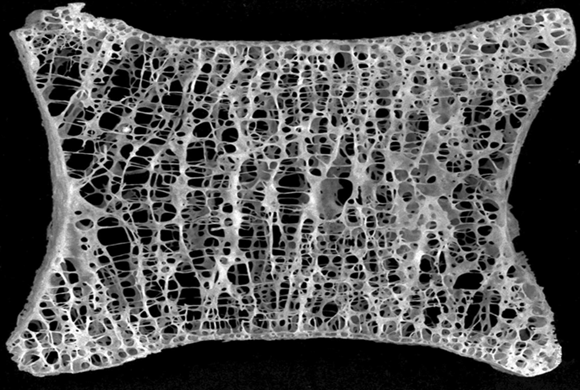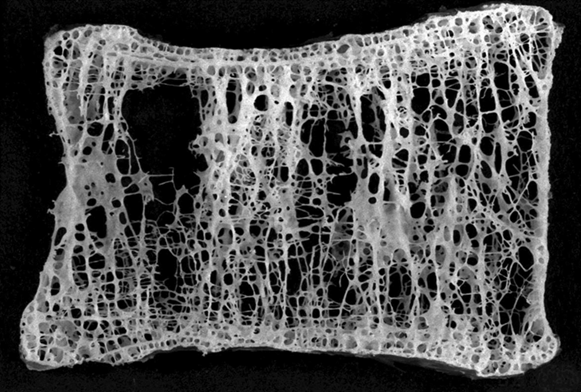The Washington University Bone Health Program offers a comprehensive and personalized assessment of osteoporosis and fracture risk, and provides individualized recommendations for fracture prevention, with a “one-stop shopping” approach.
In the same day, patients undergo measurement of bone mineral density, are assessed by a physician or a nurse practitioner and discuss the results of their bone density test and fracture risk with their provider in “real-time.” Your provider may order X-rays, blood and urinary tests, and (in rare cases) a bone biopsy. Such comprehensive, in-depth assessment allows our physician specialists to formulate personalized recommendations for preventive or therapeutic actions.
Osteoporosis, or porous bone, is a disease characterized by low bone mass and structural deterioration of bone tissue. This leads to bone fragility and an increased susceptibility to fractures of the hips, spine, and wrists. While bone loss can be slowed down by calcium and vitamin D supplements and lifestyle changes, an appropriate treatment must be individualized based on an in-depth evaluation of a patient’s skeletal health. Prescription medicines are available that prevent the progression of the disease and significantly reduce fracture risk.
On the left is a cut-through of a vertebra from a woman with normal bone density. Note the fine and well-organized trabecular pattern inside the bone. On the right is a vertebra from a woman with osteoporosis. Note the rarefied trabecular pattern, disconnected trabeculae, and even some holes in the trabecular mesh of the bone tissue. All these changes decrease bone strength.

Section of a normal vertebra 
Section of a vertebra with osteoporosis
- 25 million Americans are affected, 80% of whom are women. Of these, 7-8 million have osteoporosis and 17 million have low bone mass and increased risk.
- 1 of every 2 women & 1 in 8 men will have an osteoporosis-related fracture during their lifetime.
- By age 75, 1/3 of all men will be affected.
Osteoporosis is not just an older person’s disease; it strikes at any age. In Missouri alone, it is estimated that 168,000 women and 43,500 men have osteoporosis and 320,400 women and 62,300 men have low bone mass.
- Osteoporosis is responsible for 1.5 million fractures annually, including 300,000 hip fractures, 700,000 vertebral fractures, 200,000 wrist fractures and more than 300,000 fractures at other sites.
- Loss of dentition (teeth) is also related to bone loss in the lower jaw, or mandible.
- 40% of all women will have at least one spinal fracture by age 80.
- A woman’s risk of hip fracture is equal to her combined risk of breast, uterine & ovarian cancer.
Hip fractures are very serious, especially in older people. Among those living independently prior to a hip fracture, 15- 25% of them will remain in long-term care institutions a year after the injury. Men and women who fracture their hip have a 5- 20% greater risk of dying within the first year following the fracture than others in their age group.
Osteoporosis is a so-called silent disease because bone loss occurs without symptoms. The first external sign of osteoporosis may be a fall or a fracture. The bones become so weakened that a sudden strain, bump, or fall causes a bone to fracture or a vertebra to collapse.
Collapsed vertebrae may initially be felt or seen in the form of severe back pain, loss of height, or spinal deformities, such as stooped posture or a dowager’s hump.
There are two kinds of risks – those that you cannot change and those that you can.
Risk Factors You Can Control – What You Can Do About Bone Health
- Calcium and vitamin D intake – A diet low in calcium contributes to diminished bone density, early bone loss, and increased risk for fractures. Vitamin D is necessary for calcium absorption from the gut. You can optimize your calcium and vitamin D intake through diet and/or by taking supplements to meet the recommended amounts suggested by your physician.
- Physical activity – People who are not physically active have a higher risk of developing osteoporosis. A good level of daily weight-bearing activity, such as walking or jogging (carefully) for at least 30 minutes, is important to maintain a healthy skeleton.
- Tobacco use and excessive alcohol consumption – Research suggests that tobacco use contributes to weak bones. Similarly, having more than two alcoholic drinks per day on a regular basis increases the risk of osteoporosis.
- Eating disorders and other conditions and procedures that affect bone health – People with anorexia or bulimia are at risk of bone loss. Surgical procedures for weight loss, such as gastric bypass, or such conditions as celiac disease, Crohn’s disease or ulcerative colitis can affect your body’s ability to absorb calcium and vitamin D. Cushing’s disease and hyperthyroidism can also lead to bone loss, if not appropriately treated.
- Certain medications – Long-term use of corticosteroid medications, such as prednisone (or “steroids”), is damaging to bone. Other drugs associated with an increased risk of osteoporosis include long-term use of aromatase inhibitors to treat breast cancer, some antidepressants, and some anti-seizure medications.
Risk Factors You Cannot Control – What You Should Be Aware Of About Bone Health
- Being female – Women have smaller bones than men, and they lose bone faster at menopause as estrogen hormones decline.
- Aging – Your bones become less dense and lose their strength as you age.
- Race, frame size, and family history – Your risk is increased if you are of Caucasian or Asian descent, if you are extremely thin (with a body mass index of 19 or less), or have a small body frame. Also, having a parent or sibling with osteoporosis puts you at greater risk, especially if there is a family history of fractures.
A bone density test is the best procedure to estimate fracture risk. Your physician will interpret the bone density test result in the backdrop of all the risk factors for osteoporosis and laboratory tests, when necessary, to give you customized recommendations for lifestyle and dietary adjustments and drug therapy, if appropriate.
An online tool, the FRAX calculator, aids in estimating the risk of osteoporotic fractures based on bone density and the risk factors listed above. The FRAX calculator is useful but has some limitations that patients should be aware of, including the fact that DXA measurement at the proximal femur (hip) is required, and that it cannot be used to monitor the efficacy of drug treatment for osteoporosis. While this tool is freely available online, we strongly encourage you to consult with your specialist physician or health care provider to devise the most appropriate approach to improve and maintain your bone health.
To schedule an appointment or refer a patient, please call 314-454-7775. Offices are open Monday-Friday, 8 a.m.-4:30 p.m.
Washington University School of Medicine does not endorse or guarantee the accuracy of information contained on websites on non-affiliated external sources. Read the School of Medicine’s Policy on Links to Third-Party Websites to learn more.